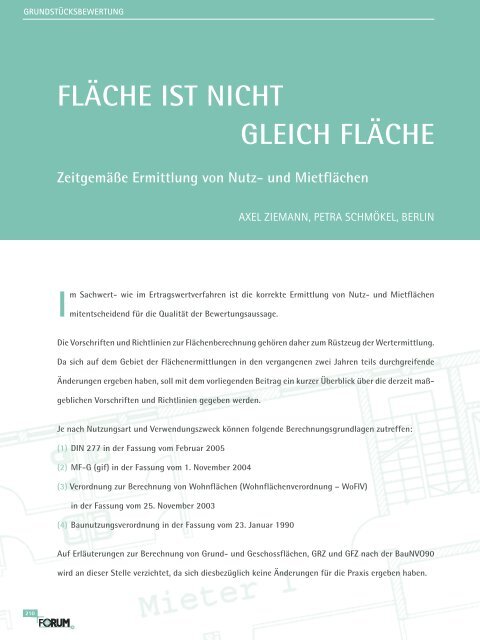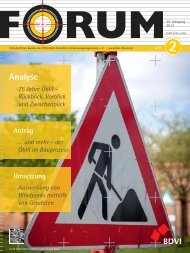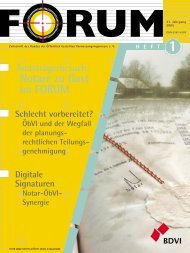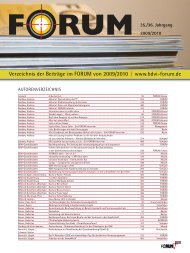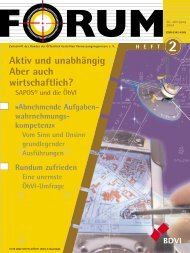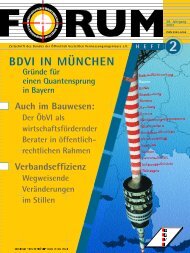Erfolgreiche ePaper selbst erstellen
Machen Sie aus Ihren PDF Publikationen ein blätterbares Flipbook mit unserer einzigartigen Google optimierten e-Paper Software.
INTERNATIONAL INTERNATIONAL<br />
226<br />
The Global Land Information Explosion<br />
GIS-ACSM-GLIS-GSDI-GITA-URISA-GE<br />
AND THE ATLANTIC INSTITUTE<br />
4<br />
GUNTHER GREULICH, BOSTON<br />
In Amerika haben der Begriff »Geographic Information Systems« und die entsprechende Abkürzung GIS schnell<br />
die etwas sperrige Bezeichnung des »Multipurpose Cadastre« (Multifunktionales Kataster) ersetzt; letztere<br />
bildete 1980 den Titel einer Studie des National Research Council (Nationaler Forschungsrat). Amerikanische und<br />
kanadische Landdatenspezialisten, z. B. Geodäten, Vermesser und Kartographen, entwickelten dieses neue Daten-<br />
management-Instrument und wurden dabei von Vertretern anderer Disziplinen unterstützt, die alle das enorme<br />
Potenzial von GIS erkannten. Eine Reihe nationaler und internationaler Organisationen, die sich GIS widmen,<br />
wurde in den letzten Jahren ins Leben gerufen. Sogar in Europa, das eine fast 300-jährige Tradition der Daten-<br />
erfassung und des Datenmanagements unter dem Begriff »Kataster« aufweist, wurde der Begriff GIS adaptiert<br />
und trug zu neuen, koordinierten Entwicklungen bei.<br />
Schon seit langem hat sich dabei insbesondere eine Organisation, The Atlantic Institute, dem Ziel gewidmet,<br />
zwischen den USA und Kanada auf der einen und Europa auf der anderen Seite eine professionelle GIS-Verbindung<br />
aufzubauen und zu pflegen. In den USA haben bundesstaatliche Regierungen damit begonnen, ihr eigenes,<br />
einzigartiges GIS zu entwickeln, und wurden dabei oft von lokalen, visionären Landvermessern inspiriert. GIS<br />
wächst weltweit und wird nicht aufzuhalten sein.<br />
Veröffentlicht in: Surveying and Land Information Science, Dec. 2004, by Greulich, Gunther.<br />
Copyright: American Congress on Surveying and Mapping, Dec. 2004.<br />
Provided by ProQuest Information and Learning Company. All rights reserved.<br />
ABSTRACT<br />
In America, the label Geographic Information Systems, or GIS<br />
for short, has quickly replaced the somewhat awkward tide<br />
“Multipurpose Cadastre,” which had been assigned to a 1980<br />
study by the National Research Council. American and Canadian<br />
land data specialists, such as geodesists, surveyors, and<br />
cartographers, developed the new land management tool and<br />
were joined by other related disciplines, which all recognized<br />
the enormous potential of GIS. Several national and international<br />
organizations, devoted to GIS, have sprung up in recent<br />
years. Even in Europe, which has nearly a 300-year tradition<br />
of land recording and management under the heading of<br />
“Cadastre,” the term has been embraced and inspired new coordinated<br />
developments. Early on, one particular organization,<br />
The Atlantic Institute, has focused on building and maintaining<br />
a professional GIS bridge between USA / Canada and<br />
Europe. In the USA, state governments have begun to create<br />
their own unique GIS, often inspired and prompted by local<br />
visionary land surveyors. GIS is growing worldwide and will<br />
be unstoppable.<br />
INTRODUCTION<br />
When in 1980 the National Research Council of the National<br />
Academy of Science published its landmark study “Need for a<br />
Multipurpose Cadastre,” it inspired new concepts for an old<br />
problem and triggered a slew of new acronyms.<br />
Cadaster is an old parcel-based European system of land registration,<br />
presumably introduced by Napoleon. Although not<br />
totally unknown in the United States – the Bureau of Land<br />
Management (BLM) has used the term – it did not fly in America.<br />
Even its broadening to “Multipurpose Cadastre” did not have<br />
the desired appeal. And so, Geographic Information Systems or<br />
GIS came into being and made the idea popular – very popular!<br />
American and Canadian geodesists, cartographers, photogrammetrists,<br />
surveyors, geographers, and land tenure administrators<br />
quickly recognized the value of the emerging new<br />
instrument of land management. The traditional land information<br />
professionals of surveying and mapping were soon<br />
joined and even overtaken by related disciplines, such as computer<br />
experts and geographic information specialists. These,<br />
in turn, branched out into use-oriented entities, where GIS was<br />
enthusiastically developed into an unlimited range of applications.<br />
There is still no end in sight to the GIS expansion.<br />
While some traditional surveying and mapping professionals<br />
have seen the trend as an encroachment on their discipline,<br />
others now see it as a challenge and opportunity.<br />
NATIONAL GIS ORGANIZATIONS<br />
Reliable Geographic Information Systems require a broad educational<br />
effort in order to function efficiently and to be economically<br />
viable. Besides the National Geodetic Survey (NGS),<br />
one of the first new organizations to pay attention to GIS was<br />
the Urban and Regional Information System Association. URISA<br />
is an association of government information technology professionals<br />
interested in applying and facilitating spatial information<br />
technology in public agencies. Details can be found on<br />
the Internet at www.neurissa.org.<br />
The American Congress on Surveying and Mapping (ACSM) has<br />
represented spatial data professionals since 1941. In response<br />
to the emerging technology, members formed a new division<br />
in 1993, now called Geographic and Land Information Society,<br />
Inc. (GLIS). One of its missions is to bring cooperation<br />
among the various mapping disciplines (Zimmer 2003). Its new<br />
website is www.glismo.org.<br />
The Geospatial Information & Technology Association (GITA)<br />
is another GIS organization promoting education and information<br />
exchange by focusing on the infrastructure of the life<br />
lines of our society and on utility applications worldwide. Its<br />
website is www.gita.org.<br />
GLOBAL SPATIAL DATA INFRASTRUCTURE<br />
In order to promote international GIS cooperation and collaboration,<br />
a brand new international organization was founded<br />
in 2003. The Global Spatial Data Infrastructure Association<br />
(GSDI) has among its founding members some leading American<br />
organizations, such as the US Federal Geographic Data<br />
Committee (FGDC) with strong support from USGS, ESRI, and<br />
Intergraph. Its main goal is to “foster spatial data infrastructure<br />
that supports sustainable social, economic, and environmental<br />
systems integrated from local to global scales.” Its international<br />
membership is open to individuals and organizations,<br />
both public and private, whose programs and purpose<br />
are consistent with the mission of GSDI. A very important part<br />
of that mission is the promotion of informed and responsible<br />
use of geographic information for the benefit of society. It is<br />
claimed that the overall concept stems from “an originally<br />
European initiative” (Aktuell 2004). In fact, we understand that<br />
GSDI is very strong and strongly supported in Europe. Its current<br />
American headquarters are at 43351 Spinks Ferry Road, Leesburg,<br />
VA 20016. For more information try jampoler@gsdiassociation.org.<br />
4<br />
227


